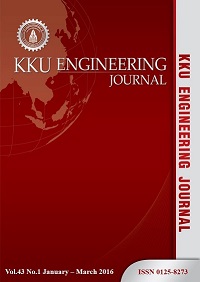The effect of remaining SDS on protein release in later leaching steps of deproteinized natural rubber
Main Article Content
Abstract
The effect of residual sodium dodecyl sulfate (SDS) used in the washing steps on further leaching of proteins from deproteinized rubber films was investigated. High-ammonia natural rubber latex (HANRL) was diluted with a 0.01% w/v potassium hydroxide solution to obtain 30% dry rubber content (DRC) solution referred to as diluted NRL. Untreated NRL was directly cast in a film (sample 0). Sample 1 was prepared from diluted NRL centrifuged at 5000 rpm for 1 min. Sample 1-2 was prepared by washing Sample 1 with a 0.5 %wt SDS solution. Sample 1-3 was prepared by washing Sample 1-2 with a 0.1%wt SDS solution. After that, they were cast into films. The dried films were checked for extractable protein (EP) using a modified Lowry method and nitrogen content determination according to SMR: Bulletin No.7-1992. The EP content of the Sample 1 film was less than the untreated (Sample 0), but the EP content was increased after washing with a 0.5 %wt SDS solution and then it decreased slightly after further washing with a 0.1 %wt SDS solution. In contrast, the nitrogen content and FTIR spectra confirmed that the total protein content of the films decreased when they underwent more treatment. This finding suggested that although overall protein content decreased, the remaining SDS on the films could facilitate further leaching of EP from the film surface when it was in contact with extraction medium (PBS or synthetic sweat) under conditions of shear. The use of this deproteinized film should, therefore, be done with care.
Article Details
How to Cite
Danwanichakul, P., Yooyanyong, A., & Danwanichakul, D. (2016). The effect of remaining SDS on protein release in later leaching steps of deproteinized natural rubber. Engineering and Applied Science Research, 43(1), 41–46. retrieved from https://ph01.tci-thaijo.org/index.php/easr/article/view/35832
Issue
Section
ORIGINAL RESEARCH
This work is licensed under a Creative Commons Attribution-NonCommercial-NoDerivatives 4.0 International License.



